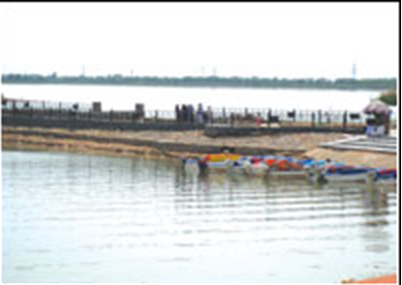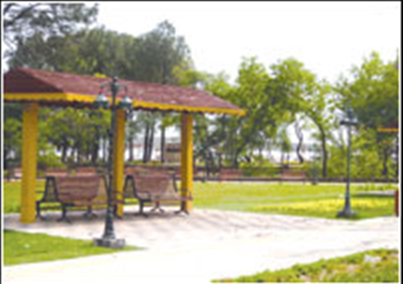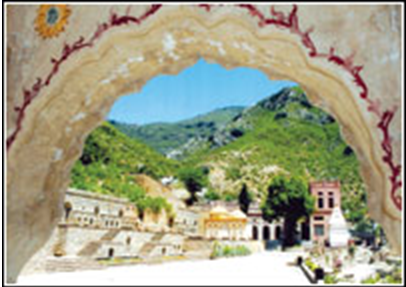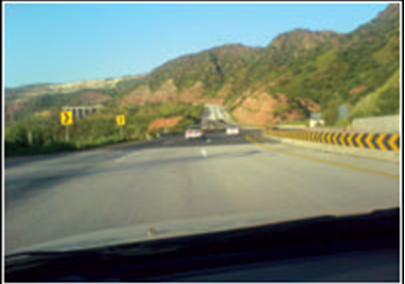Islamabad: P-Z
m (Pdewan moved page Islamabad: 2 to Islamabad: P-Z) |
Revision as of 13:24, 14 December 2013
This is a collection of articles archived for the excellence of their content. Readers will be able to edit existing articles and post new articles directly |
Contents |
Islamabad: 2
Islamabad: Rawal Lake
Lake View Park
By Gulrukh Tauseef
A visit to the Lake View Park is a perfect way to spend a wonderful Sunday afternoon with friends and family. The Rawal Lake is situated almost eight kilometres from Islamabads Zero Point and the Lake View Park that has been built there by the CDA is a marvellous partnership between man and nature.
Lush green lawns, sprawling gardens, beautifully manicured flowerbeds, a shimmering lake, gazebos, botanical gardens and a boating jetty… all are the highly welcoming attractions of the park.
It also offers facilities like an amphitheatre, skating rink, small food courts and a children’s area that guarantees hours of enjoyable activities for the whole family.
As soon as you park your car in one of the sprawling parking lots, there is an atmosphere of bustling activity and excitement. There are pony rides available for the children for Rs50 per pony. Many vendors have set up neat stalls at the entrance selling hot popcorns, burgers, French fries and cold juices, lemonades and ice creams.
When you enter the park, the lush greenery and the sheer beauty of the place takes your breath away. The path leading up to the boating jetty is lined with tall fronds and well pruned hedges. The centre path is used for walking while the sideways are used by golf carts and train on wheels to ferry visitors around the park.
The boats charge around Rs300 for a ride across the wide watery expanse but the absence of life jackets and life guards seem like a glaring omission. Another section of the lake is teeming with ducks and swans much to the delight of children scampering around the park.
There are plenty of garden seats and log tables for the picnickers. Many covered gazebos give shelter from the summer heat or rain while enhancing the beauty of the place. Wooden signs announce the directions to other attractions around the park. There is a Bar B Q area where grills are provided to the visitors to prepare their own food. In addition, there are many food stalls set up by well known restaurants offering a variety of mouth-watering snacks and meals to the visitors.
The Children’s Play area offers bouncing castle, trampoline, merry go rounds and other rides for smaller children. It is usually packed with excited kids having a time of their lives.
Another thoughtful gesture on the part of CDA is the provision of ramps for easy movement of prams and wheel chairs making sure that all areas are accessible to parents with toddlers and the elderly alike.
And the best thing of all: in spite of the thronging crowds, there is absolutely no littering. Perhaps the signs declaring that littering, spitting, plucking of flowers and throwing chewing gums will be punished and fined up to Rs300 have knocked some civic sense into our collective consciousness.
Islamabad: Saidpur
Heaven, renovated
Bilal Agha looks into all that is being done to turn Saidpur into a model village and a tourist attraction
Driving on the main Margalla Road, in Islamabad, the sign “Saidpur Village” sparks my curiosity. The story goes that in the early sixties, the Capital Development Authority purchased pockets of land from the residents of this village for a price tag of Rs100 to Rs300. However, “a Fransisi maimsahab bought the land and gave it back to the original owners as a gift,” says Muhammad Arshad, whose great-grandfathers had settled in Saidpur. The CDA denies all such claims and confirms that the land belongs to them.
If one goes by the records of the revenue department, it was in the 16th century, during the rule of Raja Ghar, that Said Khan came here and established orchards of mangoes, peaches and apricots and, till today, the footprints of Ghanadhra, Greek, Ashoka and Buddhist civilisations can be found in and around Saidpur.
It was during the mid ’60s that the government of Pakistan started to purchase small villages in the vicinity of Islamabad and merged them into it. As of now, four villages still remain as they are, Golra Sharif, Allah Ditta, Nurpur Shah and Saidpur. Saidpur has been a centre of controversy for the last few years. After failed attempts at vacating the owners from their houses in the village, the CDA kept a low profile for a while. However, the Chairman CDA, Kamran Lashari, had his mind set and eyes fixed on it. It was through a rehabilitation programme that the CDA was successful in relocating some villagers and developing the site.
Saidpur Model Village, as it has been renamed, is now a “living cultural village” within the urban setting of Islamabad.
The houses have been reconstructed using stones that were as close as possible to the original and decorated with terracotta motifs. The preservation of a mandir, a gurdawara and a haveli located in the vicinity and stones reproduced to look like those of the Ghandhara civilisation are all part of the plan to make the site a tourist attraction.
The Hindu temple has been turned into a museum, whereas work on restaurants, a café and kiosks is near completion. The plan also includes an arts and craft bazaar, where artisans, from all the four provinces, can display their goods and promote small industry products, cutting down the middleman’s commission.
The houses preserved at the site carry a mix of original, recreated or reproduced stones. The shops have been given an aesthetic facelift but are not reflective of the architecture of the old houses.
It is a tourist heaven, with its quaint market and narrow streets, old houses with carved wooden doors and windows, and the added attractions of the Zinda Pir’s bethak and the shrine of a holy woman. It is enchanting to see villagers lighting diyaas at this tomb and paying respects.
Much has been done to give a facelift to the place — the garbage has been cleared away, sewerage lines laid across the village and the streets have been carpeted. The Capital Development Authority has approved a budget of more than Rs40 million for the project and it is to be carried out in two phases. In the second phase, more area will be acquired to expand the project further and more than 100 houses will be demolished to make way for a broad-walk and other tourist attractions.
Islamabad from Karachi
Trail Of Two Cities
By Shireen Gheba Najib
The part of the highway where we had to move out of Multan on the road to Khanpur was not pleasant at all. We found ourselves in the middle of a terrible traffic jam.
We never wanted to drive to Islamabad from Karachi. We had planned to fly out, after loading our luggage into a truck along with our cat and dog.
But when the truck driver refused to take the pets, we were left with no choice.
“We’ll go by road,” I mumbled. My husband agreed. My daughter didn’t.
My husband has his own ideas of travelling with pets - ‘dog at the feet and cat in a cage’. But they had minds of their own. Dog wanted to see the view… So, Najib covered the seats with soft cardboard; then forced the cat into the cage between Paprika (dog) and my daughter. The cat created such a fuss that he ended up in my daughter’s loving lap! Soon it was a scene of peace in the back seat.
This is how we started our long journey watching the lovely sun rise, moving with the long trucks on the Super Highway from Karachi to Hyderabad.
We had started at 7.30am, and reached Hyderabad by 9.30am. The turning at Hyderabad’s Ghulam Mohammad Barrage took us on to the road to Sukker. The bypass blocked our view of the city of Hyderabad.
On the road to Sukker and Rohri, I was a bit disappointed not to find any wind-catchers on rooftops as had been the norm decades ago. Now with fans and air-conditioners, such things exist no more.
There were just a few trucks, some cars and other vehicles on the road. The CNG/petrol/diesel stops were plenty and well spaced. Instead of the cities, we saw interesting and quaint scenes like a tire repair shop whose salesman had gone off somewhere.
I felt sorry we never got round to seeing the city of Hala which is known for its pottery and other handicrafts. It is a city like Chiniot and Sialkot, with handicrafts being made in every house.
After Hyderabad, it got greener than I remembered it from my last two trips, over 20 years ago. I noticed how the cotton crop fields appeared right after Hyderabad and continued till Toba Tek Singh in Punjab. There were also rice crops, orchards of mangoes and bananas, and even sugar cane. None of the huge stretches of desert and sand were visible which I remembered from my childhood. There were just very few patches of desert.
In the Mirpurkhas area we saw women with dark complexion wearing very bright dresses. A few wore the ghagra with a short shirt and dupatta. The combinations were awesome with colours like parrot green, orange, bright yellow and shocking pink. Many women wore bangles from wrist to elbow and then again from elbow to upper arm.
The road was mostly dual carriage and in good condition. But you had to be very alert as suddenly traffic would appear from both sides due to repair work on the other side.
The monotony of the landscape soon made us hungry. We started looking for food only to discover that most of the roadside hotels were closed. We managed to get delicious cups of tea with hot rotis and tasty saalan and daal to go with it from a restaurant. A few trucks were parked outside and the drivers were given charpoys to relax. We opted to have our food in the car, discreetly parked nearby.
The road was generally good, lined by huge orchards of dates, bananas and mangoes on either side when we reached Khairpur and Sukker. In Sukker the area turned rugged and dramatic. But we could not see the Sukker Barrage which is huge and from where the Indus River is lovely to watch, overlooking the huge British train bridge. This too was not visible from the highway; we just saw the tip of the metal curve of the train bridge on the River Indus.
During our lunch stop, we saw an amusing ‘siesta scene’ with goats calmly munching around with people taking naps.
The last hundred kilometres before Bahawalpur, the road was absolutely lovely and we were in the city by sunset. It takes exactly 12 hours from Karachi to Bahawalpur with a few stops on the way. The good night’s rest and dinner at my son-in-law’s parents’ home was wonderful.
As it was a practical journey, we did not have time for sightseeing. We visited Bahawalpur a year ago and had seen the beautiful palaces there. I noticed that women straddled their motorbikes, in the back seat of course. This is very unusual for women in Pakistan who always sit with both legs on one side.
The next morning as soon as we got out of Bahawalpur we saw this quaint little mosque. I was amazed to see that the cycle rickshaws are back now and driven by people.
The part of the highway where we had to move out of Multan to the road to Khanpur was not pleasant at all. We found ourselves in the middle of a terrible traffic jam. We had decided to skip Lahore and move across Punjab, landing onto the motorway from Lahore to Islamabad after passing Toba Taik Singh. The cotton crops continued all the way, and we saw some places where some men and women were plucking cotton buds from the plants with nimble fingers.
We entered the motorway and I started driving; but soon I was handed a ticket for staying on the ‘fast lane’ for too long. You are supposed to cross a vehicle and then go back to the middle lane. Okay! That lesson cost me Rs200.
Then we drove through my favourite part of the motorway - the Kalar Kahar area. There is a lovely lake there and the road looks awesome going through the high hills. The story that goes with Kalar Kahar is great as well. When a saint asked a lady taking water to her home for some water, she declined by saying ‘this water is saltish’ (she said it’s ‘kalar’). When she went home, she found that the water that she’d taken for herself had turned saltish! The saint’s grave is located in this valley. There are peacocks that walk and dance on the roads here.
We were able to reach Islamabad by 8pm after travelling 1,550 kilometres. We made the trip in two days and had no problems at all in our longest drive in Pakistan.




